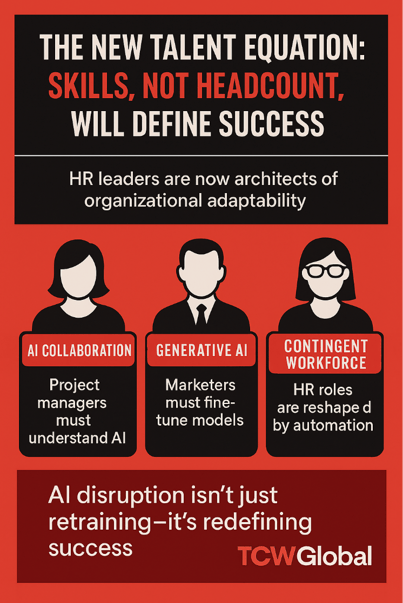The Quiet Disruption: AI’s Impact Is Here—Just Not Where You’re Looking
If you’re waiting for artificial intelligence (AI) to show up in your organization with a press release and a pink slip, you’re already behind.
The reality is quieter—and far more transformative.
AI isn’t just about headline-grabbing layoffs or futuristic robots replacing entire departments. It’s already embedded in the day-to-day fabric of your business, subtly shifting how work gets done. From chatbots that resolve support tickets in seconds to software that automates entire accounting workflows, AI is redefining job functions and organizational structures from the inside out.
For HR and technology leaders, this isn’t a conversation about “someday.” It’s a mandate for action today.
The Productivity Curve Has Shifted—And So Must Your Strategy
Traditionally, increased productivity meant more output from more people. But AI changes the math.
A single employee equipped with the right AI tools can now outperform a small team. Customer service agents resolve more issues per hour. Content marketers generate more campaigns with fewer resources. Developers complete tasks in half the time, and finance analysts let algorithms do the heavy lifting on data analysis.
The result? Organizations don’t need to lay people off—they just stop hiring replacements. Roles disappear not with drama, but with silence.
If HR leaders don’t get ahead of this shift, the business may achieve its efficiency goals—but at the cost of employee morale, trust, and preparedness.
The New Talent Equation: Skills, Not Headcount, Will Define Success
HR leaders are no longer just stewards of culture or compliance—they’re architects of organizational adaptability.
AI is accelerating demand for new hybrid skillsets. It’s not enough for someone to be a strong project manager; they must understand how to collaborate with AI tools. A good marketer? Now they need to know how to fine-tune a generative AI model. Even traditional roles like HR generalists or customer success managers are being reshaped by automation, requiring fluency in analytics, systems thinking, and digital tools.
The challenge isn’t simply retraining employees—it’s redefining what success in a role looks like.

The Internal Mobility Imperative: Move People, Don’t Lose Them
As some roles fade, others are emerging just as quickly. AI isn’t just eliminating work—it’s creating new opportunities. The problem? Most organizations aren’t set up to match people to those opportunities quickly enough.
That’s where internal mobility becomes mission-critical.
Promotions can no longer be the only upward path. Career ladders are flattening in favor of career lattices—where lateral moves into newly created or AI-enhanced roles become the norm. But this shift requires a foundation:
- Skills mapping to understand what capabilities are transferable.
- Transparent role pathways to help employees see their options.
- Learning and development programs focused on future-facing competencies like data fluency, AI literacy, and human-machine collaboration.
Companies that get this right won’t just retain their best people—they’ll redeploy them into the highest-value work of the future.
Culture vs. Capability: Why Both Matter in an AI World
It’s tempting to treat AI transformation as a technology-based approach. But if the cultural groundwork isn’t laid, even the best tools will flounder.
Employees aren’t afraid of AI because they don’t see its potential—they’re afraid because they don’t understand their place in the new equation. Will their job still exist? Will they be replaced? Will their skills matter?
HR leaders must meet this uncertainty with clarity and empathy.
- Communicate early and often about how AI will impact roles—and what support employees will receive.
- Champion a culture of continuous learning where adaptability is celebrated.
- Position AI as a partner, not a threat, by showing how it amplifies human strengths rather than replacing them.
In this new world of work, the soft skills—trust, communication, empathy—are more critical than ever.
5 Actions HR Leaders Should Take Now
The future of work is not a thought experiment—it’s a project plan. Here’s where to start:
- Audit Your Workforce for AI Readiness
Break down roles into core tasks. Which ones are automatable? Which requires human judgment? This analysis provides the roadmap for where to invest in reskilling, automation, or restructuring.
- Launch AI Literacy Initiatives
Every employee, from the C-suite to the frontline, should understand what AI is, what it isn’t, and how it fits into their work. Start with pilot programs and scale fast.
- Redesign Career Pathways
Move away from static org charts and build flexible, skills-based pathways that reflect the evolving nature of roles in your organization.
- Create Internal Talent Marketplaces
Don’t let great talent leave because they can’t see the future. Build systems that allow employees to explore new opportunities inside the company—before they look elsewhere.
- Measure What Matters
Track AI tool adoption, upskilling progress, internal mobility rates, and employee sentiment. These metrics will tell you if your strategy is actually preparing your workforce for what is next.
AI Won’t Replace Your Workforce—But It Will Replace How You Manage It
The AI era doesn’t require HR leaders to become data scientists or machine learning experts. But it does demand a strategic rethinking of people operations.
The HR teams that will thrive are those that:
- Embrace agility over tradition
- Invest in learning over outsourcing
- Lead change instead of reacting to it
- Reframe AI from a threat to a tool for empowerment
Because the real opportunity isn’t in automating jobs—it’s in elevating people to do more meaningful, strategic, and human work.
-3.png)



